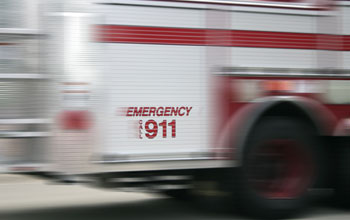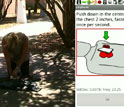News Release 13-104
Researchers Reveal Next-Generation Emergency Response Technology
Smart phone apps to be showcased at largest 9-1-1 operators conference

Innovative, smartphone emergency apps may enhance emergency response, save lives.
June 12, 2013
This material is available primarily for archival purposes. Telephone numbers or other contact information may be out of date; please see current contact information at media contacts.
Americans are accustomed to calling 9-1-1 to get help in an emergency. People with dire needs used to reach for landlines and instinctively dial the number. But what happens when the population increasingly turns to cell phones?
A research team lead by Ram Dantu of the University of North Texas sees the growth of cell phone and smart phone usage as an opportunity to improve 9-1-1 response.
With support from the National Science Foundation (NSF), his team designed several innovative smart phone apps that virtually place 9-1-1 operators at the scene of an emergency, allowing them to quickly and accurately collect information, assist victims and help first responders save lives.
"With the current smartphone technology now in everyone's hand, we thought we could do a lot better than just audio calls," said Dantu. "We can actually transmit text; we can transmit images or video. We can revamp or transform the existing emergency dispatch protocols with a next generation 9-1-1."
Dantu and his team's software can accurately monitor a victim's breathing, heart rate and blood pressure and allow 9-1-1 operators to remotely control smart phone cameras so they can view an emergency scene. The software even gives instructions and guidance before and during the administration of CPR.
The software also offers text-to-speech technology for clear communication and provides first responders GPS information of where an incident is taking place.
"Determining location was easier when people called from landlines. Operators could easily figure out where the person lived and the location from where they called," said co-principal investigator Henning Schulzinne of Columbia University and Chief Technical Officer at the Federal Communications Commission. "Some 70 percent of all emergency calls today are initiated by cell phones. Determining precise location is more challenging, particularly in buildings with many apartments and offices."
Henning worked on the text-to-speech and GPS components of the software. Other co-principal investigators focusing on other aspects of the software, including cybersecurity, were Walt Magnussen and Ana Goulart from Texas A&M University.
"NSF's investment in a testbed for Internet-based 9-1-1 services has supported strong and innovative research and development at Columbia University, the University of North Texas, and Texas A&M University," said Jeremy Epstein of NSF's Secure and Trustworthy Cyberspace Division, which funded the research. "In addition, this work has involved both undergraduate and graduate students, deepening their appreciation of the difficulties of engineering new systems in the real world of deployed emergency calling systems."
"With the advent of new technology, such as smart phones and different sensors, we should be able to get all the vital information to the 9-1-1 operators so that they can actually dispatch resources within a sixty second timeframe--that is the objective of this project," said Dantu.
Dantu will demonstrate these apps at next week's 2013 National Emergency Number Association conference, the largest annual gathering of 9-1-1 operators in the United States, to be held in Charlotte, N.C. There he hopes and expects that emergency operators will assess the software and provide valuable feedback.
There is more information in the attached webcast and video demonstrations of the technology.
-NSF-
-
The victim himself, if physically able, can transmit vital-sign information to emergency responders.
Credit and Larger Version -
View Video
Call 911: Smarter Emergency Response. Ram Dantu and Henning Schulzinne show next-generation apps.
Credit and Larger Version -
View Video
Demo of new smartphone app that collects and transmits respiratory rate to aid emergency responders.
Credit and Larger Version -
View Video
Demo of new smartphone app that collects and transmits the heart rate to aid emergency responders.
Credit and Larger Version -
View Video
Demo of new smartphone app that instructs and guides the provider of CPR to a victim.
Credit and Larger Version -
View Video
Video describing next generation 911 emergency response applications for smartphones.
Credit and Larger Version
Media Contacts
Lisa-Joy Zgorski, NSF, (703) 292-8311, email: lisajoy@nsf.gov
Leslie Wimmer, University of North Texas, (940) 565-4835, email: Leslie.Wimmer@unt.edu
Program Contacts
Jeremy Epstein, NSF, (703) 292-8950, email: jepstein@nsf.gov
Rita V. Rodriguez, NSF, (703) 292-8950, email: rrodrigu@nsf.gov
The U.S. National Science Foundation propels the nation forward by advancing fundamental research in all fields of science and engineering. NSF supports research and people by providing facilities, instruments and funding to support their ingenuity and sustain the U.S. as a global leader in research and innovation. With a fiscal year 2023 budget of $9.5 billion, NSF funds reach all 50 states through grants to nearly 2,000 colleges, universities and institutions. Each year, NSF receives more than 40,000 competitive proposals and makes about 11,000 new awards. Those awards include support for cooperative research with industry, Arctic and Antarctic research and operations, and U.S. participation in international scientific efforts.
Connect with us online
NSF website: nsf.gov
NSF News: nsf.gov/news
For News Media: nsf.gov/news/newsroom
Statistics: nsf.gov/statistics/
Awards database: nsf.gov/awardsearch/
Follow us on social
Twitter: twitter.com/NSF
Facebook: facebook.com/US.NSF
Instagram: instagram.com/nsfgov






